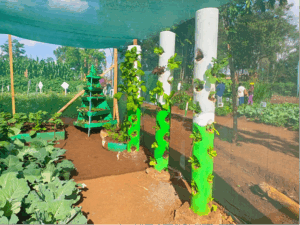Urban Farming – Kenya Agricultural and Livestock Research Organization
By Stephen Odipo
Time to embrace urban farming
Farming is not just for rural areas anymore. But is also practiced within and around cities. The Kenya Agriculture and Livestock Research Organization (KALRO) is promoting urban farming technologies as a game changer towards meeting the food demand in the urban areas.

Vertical garden (Green and white pipes) is one of the urban farming technologies showcased to farmers during the KALRO Kabete Mkulima Open Week Exhibitions at KALRO Kabete. PHOTO/STEPHEN ODIPO
During a Joint Mkulima Open Week Exhibitions at Kabete (NARL), themed “Catalyzing sustainable agricultural and economic transformation through promotion of climate-smart technologies, innovations and management practices”, KALRO displayed various urban technologies. The open week provided a platform for one on one interaction between research experts and the public.
Urban agriculture as a global phenomenon is widely promoted as a sustainable land use practice as traditional farming requires vast fields.

Dr Paddy Likhayo, Director KALRO Food Crops Research Institute, Kitale addressing participants during the opening ceremony of the event
“Dr. Paddy Likhayo, the Director of KALRO Kabete Centre, stated that unlike tubers and other soil-grown vegetables, hydroponics eliminates the need for soil. This innovative method allows for vertical farming techniques, thereby maximizing production in limited urban spaces.”
The vertical gardens, he added can be made using locally available materials making them cheaper. These gardens are easy to manage and install using different sizes of PVC pipes, media for plant growth and supporting stand that can be either wooden or metallic. The technology can be used to grow different vegetables.
“Crops with deep roots such as carrots and potatoes which require more root space cannot be planted on vertical gardens but on round raised kitchen gardens to enable them have enough room for bearing.” Dr. Paddy explained.
He noted that, “the common vegetables which tend to be mostly consumed in urban settlements that thrive well includes; Managu, Sukuma wiki, lettuce, Spices, onions, tomatoes, eggplant and capsicum though they need extra support especially in their bearing stage.”
According to the Ministry of Agriculture, the average age of a Kenyan farmer is 60 years. This means that more youths need to take their place in farming. Through promotion of these simple technologies KALRO targets to attract youth and individuals who do not have access to large farming land. By embracing these technologies the youths and jobless in urban areas can be self-employed.
Urban planners can also consider allocating spaces in their development plans where city dwellers can engage in urban farming practices. According to a 2018 report by FAO, approximately 68% percent of the world’s population is projected to live in urban areas by 2050.
This rapid urbanization poses a significant challenge for food production and distribution systems as agricultural land becomes scarce and transportation distances increase.
Experts say solutions such as vertical gardening and hydroponics championed by KALRO should be embraced as innovative solutions to enhance food and nutrition security within these settlements.

KALRO expert providing information during the exhibition








